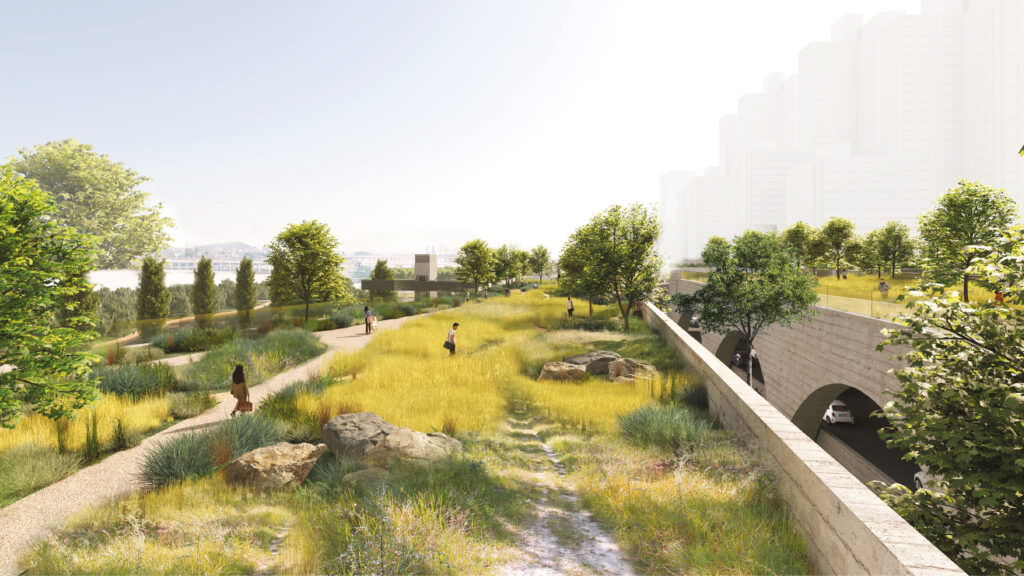
November 6, 2025
2695 Banpo Hangang River Connection Park Seoul
2695 Banpo Hangang River Connection Park Seoul
Location:
Seoul, South Korea
Project Phases: Competition 2024, 1st Prize; Planning from 2024
Client:
Banpo Jugong Complex 1 (Districts 1, 2, and 4) Housing Reconstruction Project Association
Team:
LEEON Architects, Lokaldesign, Studio Vulkan, Seoahn Total Landscape
Visualizations:
LEEON Architects, Lokaldesign, Studio Vulkan
Photography:
LEEON Architects, Lokaldesign, Studio Vulkan
Details:
The Ground Remembers
Our approach is grounded in a deep respect for the land’s inherent characteristics – its topography, soil, and hydrology. Rather than imposing form, we work with these conditions to shape resilient, biodiverse environments where vegetation can establish and evolve naturally. Through careful plant selection, spatial composition, and adaptive maintenance, we foster ecological succession and long-term vitality. Our aim is to create landscapes that allow natural processes to unfold, supporting both rooted ecosystems and cultural identity. The Banpo Park is not a design of static objects but of living systems framework that facilitates a dynamic, reciprocal relationship between people and place.
Following the course of the river, the site reveals a sequence of varied spatial atmospheres – shifting from infrastructural edges to urban intensity and eventually opening into coastal ecologies. Despite the dense development nearby, the site offers a quiet counterpoint – a threshold of calm along the water. These diverse zones weave together into a coherent and legible urban landscape.
A delta-like green corridor threads between new high-rises, linking a broader network of bike routes and parks. This corridor extends southward to larger green areas and northward into urban fabric. The adjacent island, situated near the new bridge, offers latent potential and – with minimal intervention – could be integrated into the larger ecological system.
A linear sequence of public uses animates the ground level, forming a necklace of activity that ascends over the bridge via ramps. The lower areas host playgrounds, sensory trails, and urban woodland, while the elevated bridge serves as a quieter zone – offering panoramic views and immersion in vegetation. Architectural follies punctuate the landscape, including one structure (108) that houses a museum and sunken garden.
The planting concept is structured around distinct vegetation typologies that respond to both ecological and spatial intentions. A forest-like park floor forms the base, where native and ornamental species coexist in a layered, semi-wild composition. Metasequoia trees are strategically placed to reference the site’s historical context, while open clearings framed by dense shrub plantings create varied spatial experiences and microhabitats. A sunken garden introduces a curated botanical richness, offering moments of immersion and contrast. Atop the bridge, meadow ecosystems unfold – interspersed with trees and quiet niches for reflection. Together, these diverse plant communities enhance ecological resilience and promote complex, adaptive habitats.
Circulation through the site is structured by three primary path systems, each offering distinct spatial and sensory experiences. At ground level, paths with natural surfacing maintain a close connection to the soil, encouraging a tactile and immersive engagement with the landscape. Gently sloping ramps ascend across the bridge, drawing visitors upward through open, light-filled spaces. Above, informal paths weave through the bridge park, inviting exploration and offering quiet moments of retreat. Together, these circulation layers accommodate a range of movement – from active play to contemplative pause – fostering diverse interactions with the site. The design embraces seasonal and diurnal rhythms. Vegetation is selected for year-round interest – colorful bark, winter blooms, and changing textures. Lighting is selectively deployed to enhance ambiance while protecting nocturnal ecologies. Certain areas remain intentionally dark, respecting the value of night within the urban ecosystem.